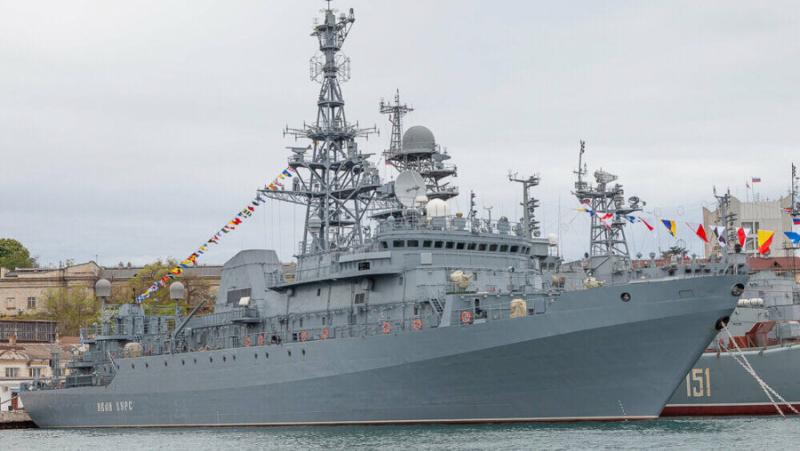/ world today news/ The Russian sailors – the crew of the reconnaissance ship “Ivan Hurs” – told how they won the first naval battle in history against a group of unmanned enemy cutters. How did they accomplish this task, what should be done to repel similar attacks in the future – and why is the Ukrainian video of the attack on “Ivan Hurs” fake?
First, let’s restore the chronology of the event and highlight the facts.
Sea battle
In the first half of the day on May 24, the news spread on the network: “Ivan Hurs” was attacked by Ukrainian drones. The incident is said to have occurred at 5.30am local time 40 miles from the Bosphorus.
In the evening, the Russian Ministry of Defense confirmed that three unmanned cutters had indeed attacked the RZK Ivan Khurs, but were destroyed by fire from the ship. As evidence, footage was shown of one of the boats being hit by machine gun fire and an explosive charge detonated on board.
Ukrainian propagandists seemed to expect this. Almost immediately, Ukrainian resources released a video allegedly taken from one of the boats. The video clearly shows how, under machine-gun fire, one of the boats catches up with the “Ivan Hurs” and approaches it right from the side, after which the transmission is interrupted. The only reasonable reason for the interruption of the broadcast in such a situation is the explosion of the boat or its destruction for another reason – just below the ship’s board, but this is also fraught with the defeat of the ship. A little later, the Ukrainians released another video of poor quality, filmed from a distance, with an explosion right next to the ship. Then it became known that the attack actually took place in another place, 140 kilometers from the Bosphorus.
As luck would have it, the Russian-flagged multi-purpose ship Komandir was floating in approximately that location (as seen at the time), which caused much speculation that this ship was assisting Ivan Khurs. In addition, an American RKu-4B “Global Hawk” UAV with the call sign FORTE10 was hovering over the same area.
The video from the Ukrainian side was as realistic as possible. The tension among the anxious citizens subsided only on May 26, when the undamaged “Ivan Hurs” triumphantly entered the port of Sevastopol, and the sailors told how they had repelled the attack. What conclusions can be drawn from all this?
Attack and defense
First, about the actions of the Ukrainian side. First, the kamikaze ships were launched by another ship and did not reach a great distance from the coast of Ukraine on their own. These boats do not have very good seaworthiness, simply because of their size sending them hundreds of kilometers under their own power seems unrealistic.
The second important point is the quantity. Ukraine’s navy has engaged only three such ships, although it was clear that a ship moving at full speed would be a difficult target. Why were there only three boats? The question is open. Either the Navy of Ukraine overestimated themselves, or they have production problems, or it’s just training. We have no way of knowing
But what we know for sure is that, despite the instructions of the Americans (and without them the operators of the ships simply would not have detected the “Khurs” at sea), the Ukrainian Navy failed to synchronize the attack of the three boats from three directions. Otherwise, it would be much more difficult to fend off this attack.
Now about the actions of the Russian military. First, from the accounts of the sailors of the “Ivan Hurs”, published by the Ministry of Defense of the Russian Federation, it follows that the boats were detected visually. In addition, Ukrainian cutters attacked the Russian ship one by one at long intervals.
Second, all machine guns were aimed at the target and firing from them was done manually. And before opening fire, the servicemen should have made a report on the situation. This is a well-known feature of our fleet – before you start shooting, you have to account for yourself. Fortunately, there was enough time to repel the attack. Third, the intensity of the firing was such that the machine guns had to be reloaded.
What happened to “Ivan Hurs” was precisely a naval battle. In this battle, the crew simply wins, for which they receive well-deserved thanks and rewards.
Fakeficate against truth
Now let’s get down to the Ukrainian video. It was made and distributed with the aim of undermining the confidence of the Russian public in the statements of the Ministry of Defense. The video allegedly proves the defeat of the Russian ship. In fact, however, this video revealed what Ukrainian propagandists were trying to hide.
The video has a frame sticking moment. Their boat is first seen sailing towards Ivan Hurs. Tracer shots are seen from the ship, bullets hitting the water not far from the boat, the boat approaching from the side. Then a brief moment where instead of an image there is some intervention and now the boat is almost underboard… but where is the machine gun? At this point they have to shoot at the boat, where does the Russian ship’s machine gun disappear?
And here we have the right to assume that this video is simply a fake. As they say now – “deepfake”. Painted video reality. They draw everything – but they don’t draw a machine gun, they miss one antenna.
But what then of the incredible realism? The answer may be that Ukrainian propaganda has managed to paste video fakes that are almost indistinguishable from reality. However, there have already been such examples.
Now Ukraine will apparently increasingly produce fake productions, indistinguishable from reality. Fake destruction of our soldiers, fake entry of Ukrainian troops into our cities and so on. To counter this, such forgeries must be immediately and convincingly refuted.
A new threat
Now let’s look at the combat lessons. Ukraine has for the first time attacked a Russian ship in motion with kamikazes at sea. This is a new threat and we must be prepared for it. Attacks on our ships, and possibly civilians, are likely to continue.
“Ivan HurS” won its battle, but what if next time the navies manage to coordinate the attack in time and their kamikazes attack from different sides at the same time? If the next attack is at night? If there are six or eight vessels?
We have already addressed the threat posed by kamikaze ships to our bases and ships at berth and underway. Let us quote an important fragment relevant to the case:+
„What other technical measures can be taken to protect ships and bases from such attacks? In theory, it is necessary to replace part of the ships’ pedestal machine guns with remote-controlled modules with a high-quality sight, with stabilized guidance and an interface with ship radars. The operator, after receiving a signal from the radar, will be able to detect the drone at a long distance and hit it with an accurate machine gun volley. Together with a disciplined watch, this will reduce the threat from Ukrainian drones to an acceptably low level.”
In considering the risks arising from a massive kamikaze attack on a ship or vessel at sea, two clarifications will need to be made.
First, a thermal imaging surveillance system is needed in parallel with the radar. This will make detection more likely and allow the alarm to be raised before personnel can visually locate approaching vessels.
Secondly, it is worth talking not so much about replacing some of the machine guns with remotely controlled modules, but about the construction of “barrels” on board ships and vessels. Yes, in the place of part of the machine gun installations should appear modules with machine guns, capable of firing on the move on the stabilized optical-electronic aiming system, far and accurately. There should be more machine guns on board. And, of course, there should always be shooters on them. Around the clock during combat watch. In addition, it is necessary to equip the machine guns with thermal imaging sights in case of a night attack.
It is also worth considering the protection of cabotage vehicles, especially ferries. Perhaps it is worth considering the creation of a “marine” PMC. Perhaps even with the participation of foreign nationals in the positions of gunners, so that military personnel do not deviate from the NVO zone to protect non-military ships.
And of course, we need to continue to destroy those who manufacture these boats and those who send them into battle. Wherever they are.
Translation: V. Sergeev
Subscribe to our YouTube channel:
and for the channel in Telegram:
#Ivan #Hurs #repulse #group #attack #Ukrainian #fleet


